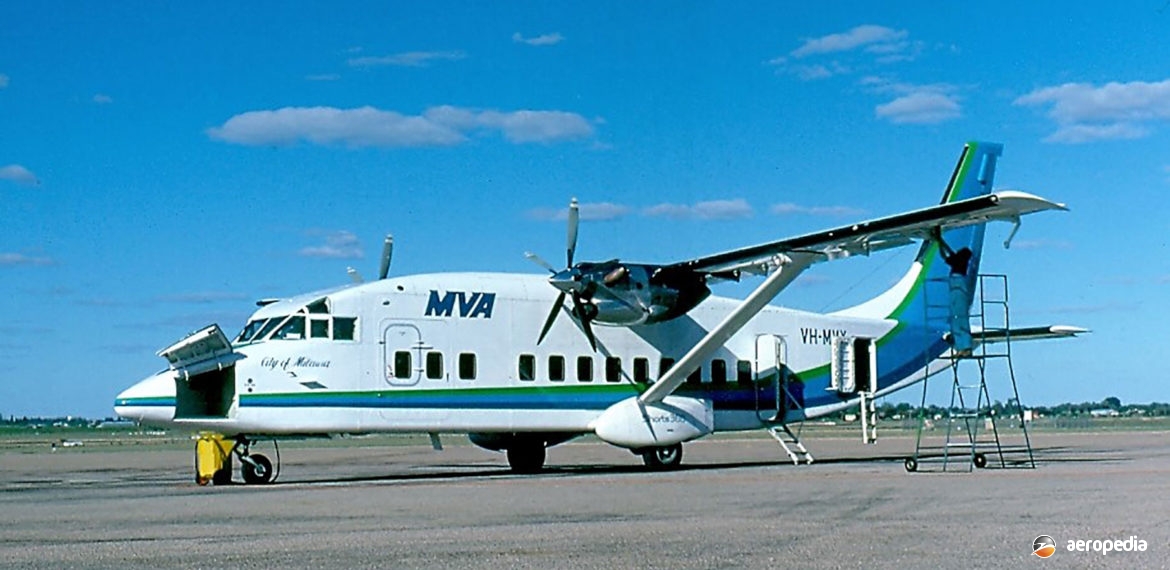Photograph:
Shorts 360 VH-MVX (c/n SH.3620)of Murray Valley Airlines at Mildura, VIC in October 1984 (David C Eyre)
Country of origin:
United Kingdom
Description:
Commuter airliner
Power Plant:
Two 990 kw (1,327 shp) Pratt & Whitney PT6A-65R turboprops
Specifications:
- Wingspan: 22.81 m (74 ft 10 in)
- Length: 21.59 m (70 ft 10 in)
- Height: 7.21 m (23 ft 8 in)
- Wing area: 42.1 m² (453 sq ft)
- Max cruising speed at 3,050 m (10,000 ft): 393 km/h (244 mph)
- Economical cruising speed: 370 km/h (230 mph)
- Certificated operating altitude: 6,100 m (20,000 ft)
- Range at max cruise with 160 km (100 miles) diversion, 45 mins reserve and max payload: 579 km (360 miles)
- Range with max fuel and reserves: 1,384 km (860 miles)
- Empty weight: 7,666 kg (16,900 lb)
- Loaded weight: 11,793 kg (26,000 lb)
- Max cargo payload: 3,765 kg (8,300 lb)
History:
The Shorts 360 was designed basically as a larger version of the Shorts 330, but to be marketed alongside that type, to meet the needs of a number of operators. The 360 differed from the 330 mainly in having a 91 cm (3 ft) lengthening of the cabin ahead of the wing to permit cabin capacity to be increased by two rows of seats, permitting a flight crew of two and 36 passengers to be carried. It also had a re-designed rear fuselage and tail assembly, which produced a lower aerodynamic drag and higher performance. Shorts advertised the 360 as ”space is the operative word on board the new wide-bodied Shorts 360 commuter aircraft. Space for 36 passengers to relax in air-conditioned comfort; space to stand up and walk about; space for overhead lockers and wide-view windows; space for galley and toilet facilities; space for a stewardess to provide in-flight cabin service.”
The prototype of the 360 series (G-ROOM), built in Belfast, Northern Ireland, was flown for the first time on 1 June 1981, being demonstrated at the Paris Airshow within a few days, being followed by the first production aircraft on 19 August 1982. Type certification was received the following month and customer deliveries began in May 1983. The first 360 delivered (N360SA – c/n SH.3601) flew on 19 August 1982 and was delivered to Suburban Airlines in the USA.
Largest operator in the United Kingdom was British Midland. Other operators have included CCAir in North Carolina, States West in Arizona, Suburban Airlines in Pennsylvania, Allegheny Commuter, Piedmont Airlines, Wright Air Lines of Ohio, Aer Lingus in Ireland, Jersey European, Thai Airways, etc. Designed as an un-pressurised commuter airliner, the type became reasonably popular with large third-level operators but was overtaken by the SAAB 340 and de Havilland Canada Dash 8 so was only sold in small numbers in this region.
The 360 sold well and for some years the initial production variant, becoming known as the 360-100, and the 360-200, were the backbone of many successful regional airlines in the United Kingdom and North America but production of the 360 series ceased in 1991 after 165 had been delivered. Flight crew was two, and typical passenger seating was for 36 at three abreast in 12 rows.
In 1985 Shorts commenced to develop a new variant to meet the competitions transit speed, which was lacking in the 360. To this end it produced the 360-300, which had a power increase to the 1,062 kw (1,424 shp) Pratt & Whitney Canada PT6A-67R turboprops driving six-blade Hartzell propellers. With some minor drag-reducing modifications, cruising speed was increased to 400 km/h (249 mph). Other improvements included a strengthened floor to accommodate heavy freight loads, improved seating, low pressure tyres and new avionics. The 360-300F freighter variant could carry up to five standard LD3 containers or pallets.
Operators in Australia included Murray Valley Airlines of Mildura, VIC with VH-MVW (c/n SH.3626) and VH-MVX (c/n SH.3620), these aircraft operations in Victoria commencing in 1983, particularly between Melbourne and Mildura. Sunstate Airlines, based in Townsville, QLD operated the type on services along the south Queensland coast, serving the centres of Gladstone, Bundaberg, Maryborough, Brampton Island, Cairns, Dunk Island, Emerald, Hervey Bay etc, its first 360 entering service in June 1984; and also operated the type in Victoria. Its fleet included: VH-FCU (c/n SH.3630 – City of Bundaberg), VH-BWO (c/n SH.3651), VH-MVW, (c/n SH.3626), VH-MVX (c/n SH.3620), VH-SUF (c/n SH.3764), VH-SUL (c/n SH.3752), VH-SUM (c/n SH.3720) and VH-SUR (c/n SH.3728), the latter two being obtained in 2004 and 2005 from overseas operators.
Hazelton Airlines replaced Embraer Bandeirantes with the 360, being VH-MJH (c/n SH.3758) and VH-MJU (c/n SH.3736), operating on the Sydney to Orange, Bathurst, Merimbula, Moruya and Dubbo routes. Airlines of Tasmania VH-TAO (c/n SH.3647) operated the type for a period, this airline having routes throughout Tasmania and to King Island and Flinders Island. State Air in South Australia, Air Hibiscus and TNT each operated VH-MVW on freight work, this aircraft having operated with almost all of the Shorts 360 operators in its life in Australia.
In 1985 at the Paris Airshow, Shorts unveiled a new un-pressurised regional airliner, the 44 to 49-seat Shorts 450, featuring a stretch of the Model 360 fuselage by 2.84 m (9 ft 4 in), a revised undercarriage arrangement, a new wing centre section and 1,155 kw (1,550 shp) turboprops driving 2.97 m (9 ft 9 in) six-blade propellers. In the event the new design did not proceed. In later years, as the 360 was replaced by new types, they were obtained by the manufacturers and re-manufactured as the Short C-23+ Sherpa transport for the US Army National Guard, the single-fin being removed and replaced with the twin-fins of the Model 330.

